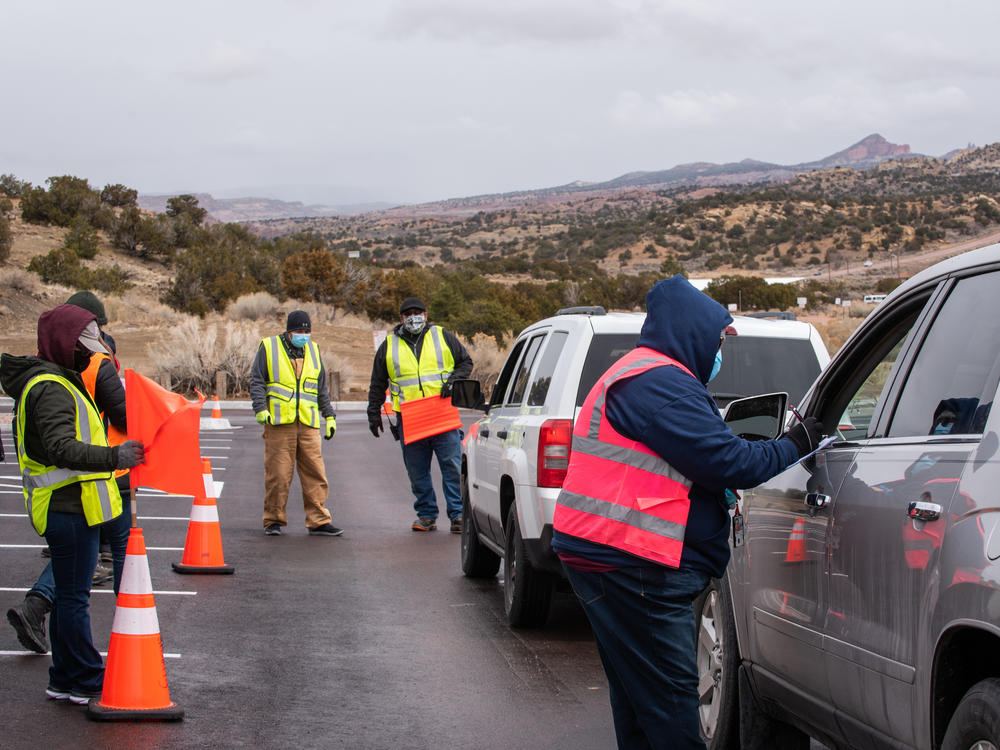Section Branding
Header Content
Outpacing The U.S., Hard-Hit Navajo Nation Has Vaccinated More Than Half Of Adults
Primary Content
The Navajo Nation has vaccinated more than half of its adult population against COVID-19, outpacing the U.S. national rate and marking a significant turnaround for what was once the site of the highest per-capita infection rate in the country.
About half of the tribe's more than 300,000 enrolled members live on its reservation, which spans Arizona, New Mexico and Utah and is considered the largest in the country. Navajo Nation President Jonathan Nez celebrated the success of the vaccine rollout but urged continued caution in a statement on Sunday.
"Over half of the adult population on the Navajo Nation has been vaccinated, but to reach herd immunity we need more people to get vaccinated," he said. "The great work being done by our frontline health care workers is being recognized nationally and rightfully so. ... Please help them by continuing to take all precautions and staying safe."
According to the Navajo Times, 87.8% of the eligible population — or more than 8 out of 10 people — had received at least one dose as of Friday, and 38.4% had been fully vaccinated. In contrast, NPR's vaccine tracker reports as of Monday, that 42.2% of the U.S. population has had at least one dose and 28.5% has been fully vaccinated.
The Navajo Nation recorded 26 new cases and 10 deaths over the weekend — a marked departure from the end of last year, when it was reporting an "uncontrolled spread" of coronavirus across 75 of its communities.
The coronavirus has hit tribal communities across the U.S. disproportionately hard: Native Americans are among the most at risk when it comes to contracting the virus, and have died at more than twice the rate of white people.
The Navajo Nation specifically has seen some of the country's highest infection rates compared to other states, and in May was home to the highest per-capita infection rate in the U.S.
Cases surged again in November and December, driven largely by social gatherings, and prompted a series of lockdown orders. And while the Navajo Nation's public health orders have been strict, the states that it encompasses have taken different approaches. As Nez told NPR in January, Arizona did not have a statewide mask mandate, while New Mexico did.
"We're like an island, the Navajo Nation within these three states," he said. "If other areas around us are not taking it seriously, it does impact the Navajo Nation."
The rapid spread of the disease has also been attributed to challenges that the reservation has faced for years, like the lack of clean, running water and reliable electricity in many households and the fact that hospitals are few and far apart. The vast geography and lack of infrastructure only made contract tracing efforts even more difficult.
The Indian Health Service has been "underfunded since its inception," Nez told CBS' Face the Nation earlier this month. On a more optimistic note, he said that healthcare professionals have been making the most of their limited resources and that the Biden administration's American Rescue Plan is expected to help facilitate its economic recovery.
Despite logistical challenges and initial vaccine hesitancy, the Navajo Nation's vaccine rollout got off to a strong start — and by the end of January, 1 in 5 residents had received at least one dose. The numbers rose quickly from there.
"I think just because of how hard hit the Navajo Nation was, we've seen a big increase in participation in taking the vaccine," Nez told Face the Nation.
First Lady Jill Biden got a glimpse of that effort last week during a two-day visit to the reservation, where she met with students, educators, women leaders, business owners and health care workers. One of her stops was a vaccination site, which Nez said demonstrates the Biden administration's commitment to "the Navajo Nation and all of our health care workers."
Now, the Navajo Nation is taking steps toward easing certain public health measures.
It moved into "yellow status" on Monday, allowing marinas, parks, museums and indoor dining to open at 25% capacity and most other businesses to operate at 50% capacity.
A separate order allows gatherings of no more than 15 people with face masks and social distancing required, and permits church services and drive-through gatherings with limited occupancy. Gyms and movie theaters remain closed, and a curfew is in place between 11 p.m. and 5 a.m.
In his statement, Nez urged people to continue "pushing back on the virus" by staying home as much as possible, avoiding large gatherings, wearing a mask, practicing social distancing and washing their hands often.
"The pandemic has led to many challenges, but it is also making us stronger and giving us a renewed appreciation for our blessings in life," said Navajo Nation Vice President Myron Lizer. "We have to continue to pray for more strength every day and keep supporting one another. We are in this together and we are overcoming this pandemic day by day."
Copyright 2021 NPR. To see more, visit https://www.npr.org.

